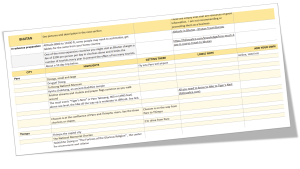Ladakh
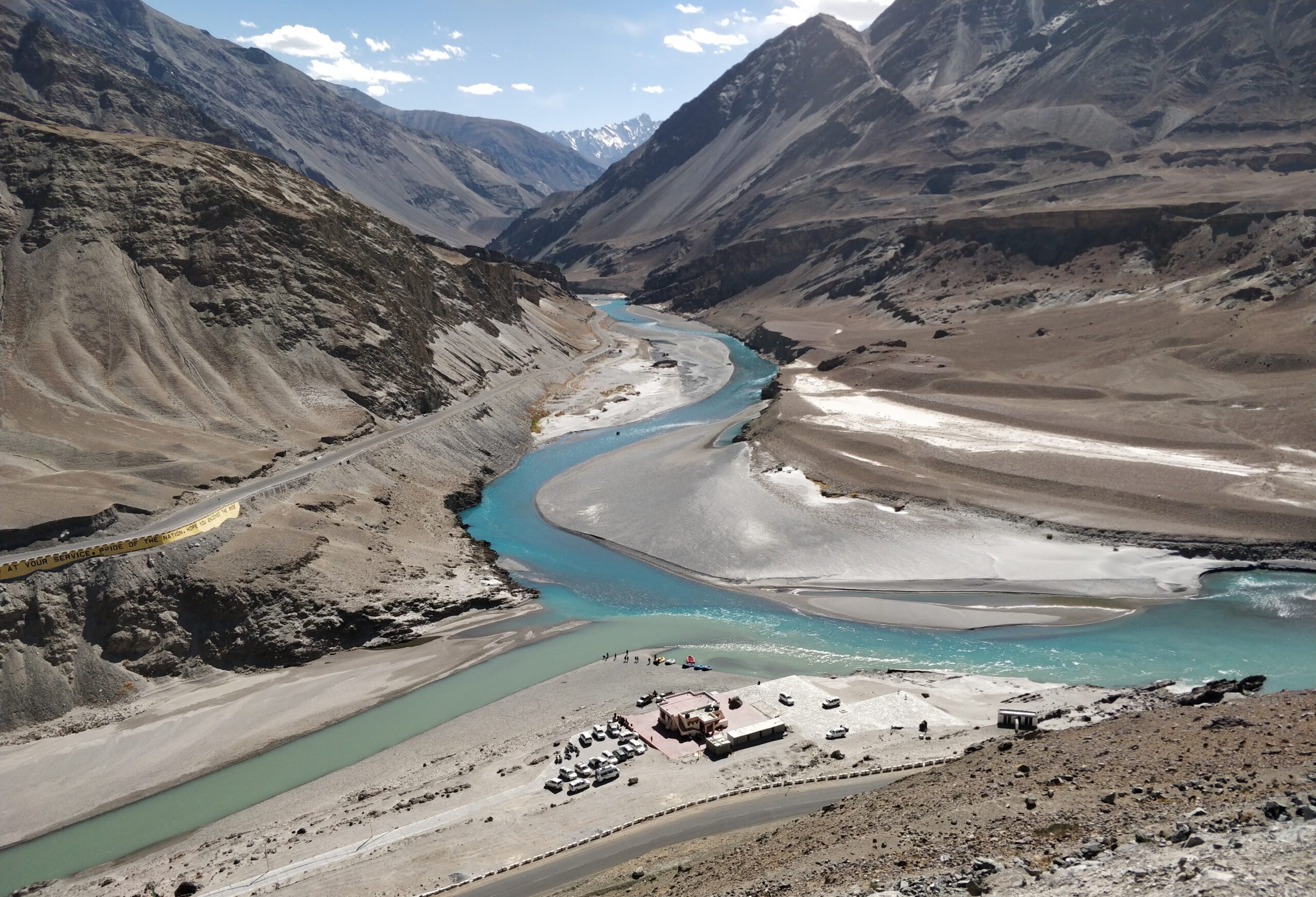
Cover: Confluence of Indus and Zanskar, Ladakh
Ladakh is one of the coldest deserts in the world, perched at a height of over 11,000 ft above sea level, with some parts of it higher than 17000 feet. It is an excellent destination for mountains, rivers, glacial lakes, many incredible landscapes, and adventure sports.
Ladakh is a region that constitutes an eastern portion of the larger Kashmir region. Ladakh is bordered by the Tibet to the east, the Indian state of Himachal Pradesh to the south, Jammu-Kashmir to the west. The Karakoram Pass is to the far north. Leh is its largest town and many a time the region is referred to as Leh Ladakh.
This link attractions | Incredible India is an excellent resource for places to visit in Leh Ladakh.
Zoom in and out to view pins. Use the Share icon on top right corner of the map to send it to your phone or email.
Click on the blue pins to see the name of the place.
What’s on this page?
IMPORTANT
- For any serious travel planning and to enhance your experience with the pictures, view all blog pages on a laptop/large screen versus on the phone.
- All the text content is in the collapsible sections (+ to open, – to close).
- Every picture on the site has a caption that is not visibly displayed. How to see the name or location in pictures of interest? If using a laptop, hover over the image. If using a mobile, hold finger down on the image. (This instruction may vary with browsers, and type of device such as iphone and Andriod).
NEED HELP WITH TRIP PLANNING?
You can use the Highlights section to create your own itinerary.
But no time or inclination to delve into details? No worries!
I will curate and customize a trip for you, based on your interests and needs. You will receive a well-planned day-by-day itinerary and travel advice.
Visit Services & About for more details.
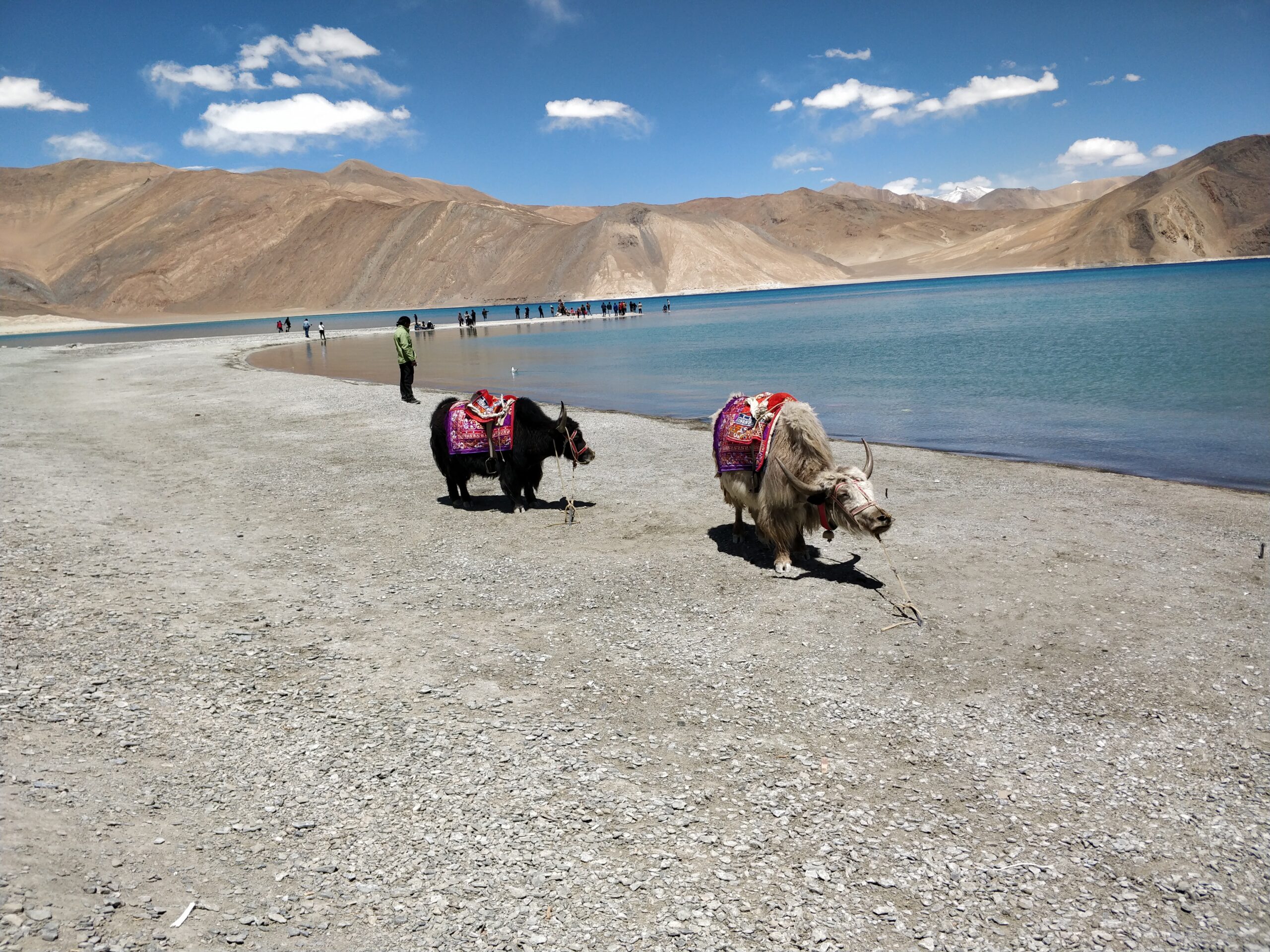
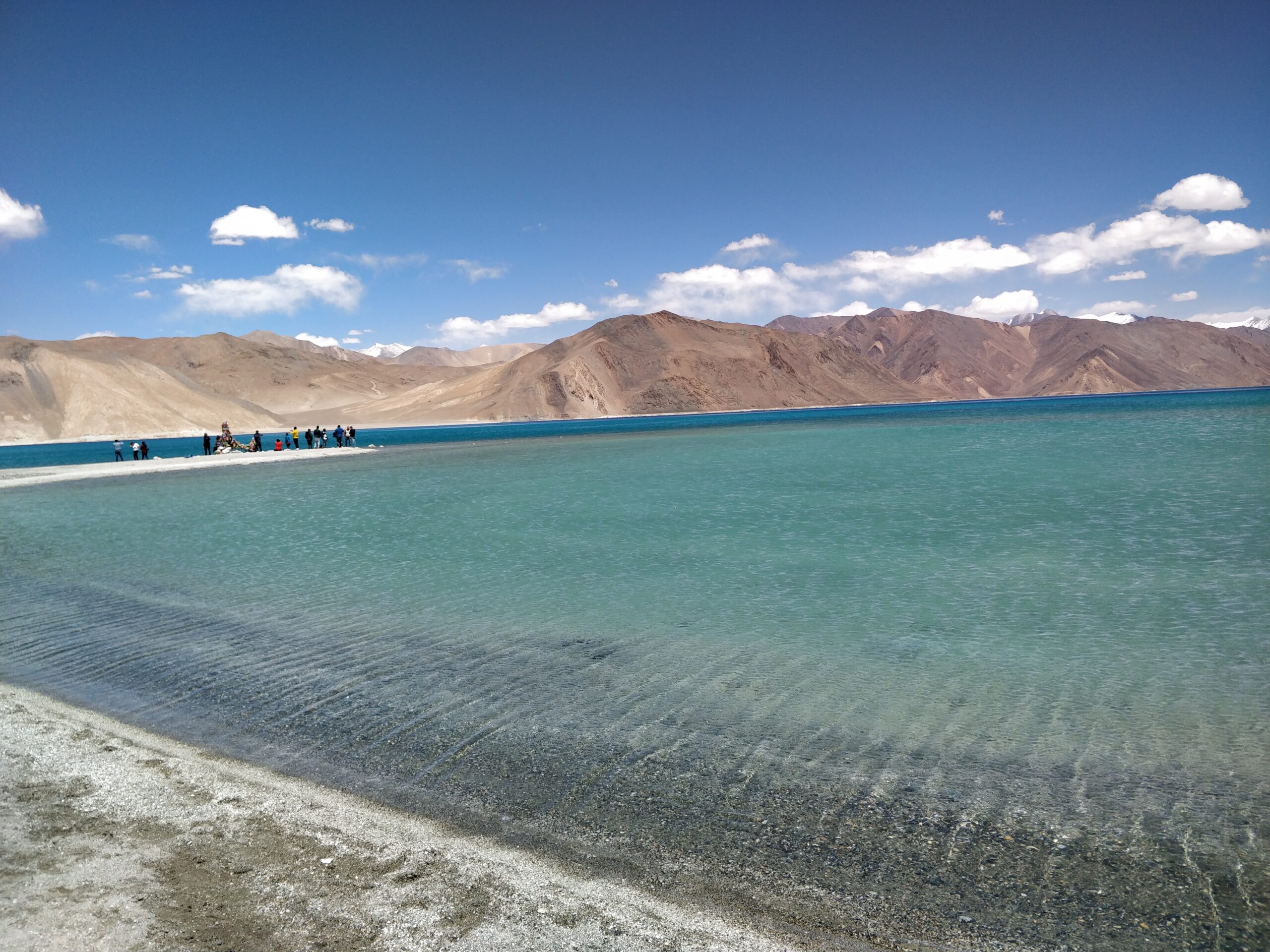
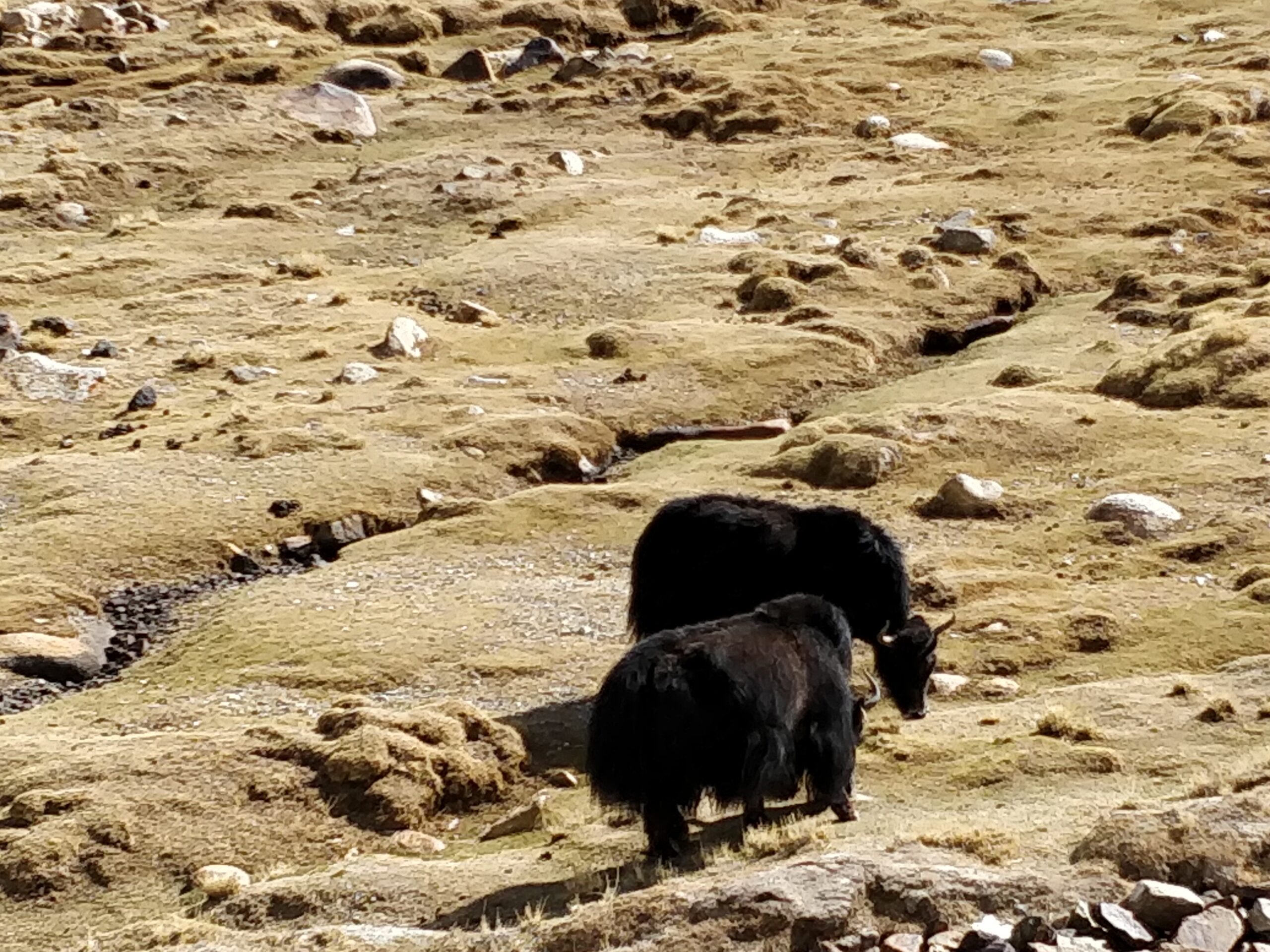
Tidbits
Know the Essentials
Official currency is the Indian Rupee. Use cash. Credit cards are rarely accepted. Also, because the network is pretty non-existent in places, shops cannot use credit cards machines. Mobile and Internet Network overall is very patchy and sometimes non-existent. So, if you are looking at being off the grid, then there is no better place.
The electricity uses 220 to 240 volt, 50 Hz cycle electricity. For India there are three associated plug types, types C, D and M. Plug type C is the plug which has two round pins, plug type D is the plug which has three round pins in a triangular pattern and plug type M is the plug which also has three round pins. Travel Adaptor for India | Electrical Safety First for pictures and more.
Take a backup battery pack and extra batteries for digital products like camera, mobiles phones, etc, as there may be electricity problem in Ladakh. It is advisable to charge them fully before leaving for the tour. At some remote places, you may not get electricity and also because of the cold, the batteries get discharged soon.
Most of Leh Ladhak has limited electricity post 9 PM. So make sure to carry a torch. The fantastic night sky makes it worth the while.
Language spoken is Ladakhi. However, a smattering of English and Hindi will get one by pretty easily.
Tourists feel pretty safe in Leh Ladakh. With the border to Pakistan and China being so close, there is a lot of military presence. While it is not volatile, it is best to check travel advisories before heading to the region.
Blog Writer, Contributor Credits
Thanks to my friend Rama Vennelakanti from Bangalore, for her writing in the narrative section and pictures after she went on an amazing motorbike trip to Ladakh on a self-discovery trip before her milestone birthday. While the narration is about her experience in the region on a bike, you can use any mode of transport (or arrange it through a tour operator) to get to the places mentioned in this blog.
All blog pages are best viewed on a laptop/large screen versus on the phone, especially for any serious travel planning, to minimize scrolling and to appreciate its larger-than-life pictures. Depending on the device you are using, hover or hold down on an image for its name/location. Note: There are other similar websites and so don’t miss the s and the u in Travels to Savour (travels to savour 🙂).
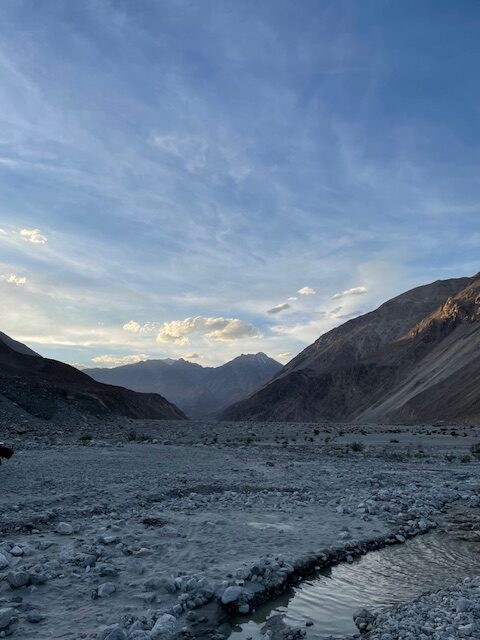
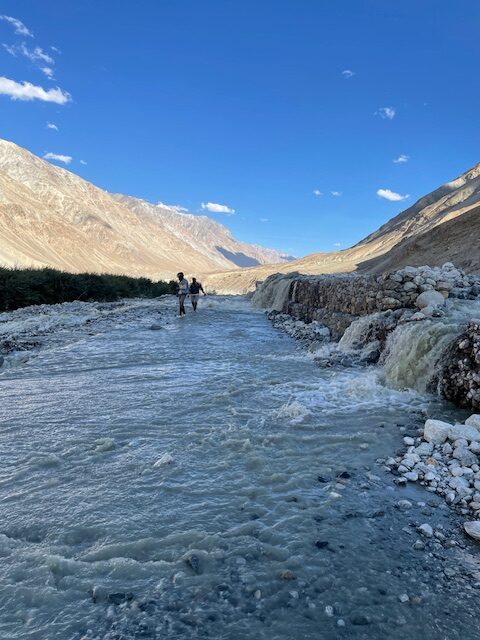
Highlights
Getting to Leh: Getting to Leh is easiest by flight. The number of flights each day depends on the weather. Landing in Leh perforce requires that you give yourself two days to lie down and not exert yourself in any way, till you get acclimatized to the heights and the low oxygen levels.
Pangong Tso Lake: This stunning high-altitude lake stretches from India to China and is famous for its ever-changing shades of blue. It gained international fame after being featured in the Indian movie “3 Idiots.”
Nubra Valley: Known as the Valley of Flowers, Nubra is a mesmerizing cold desert with lush green villages, sand dunes, and the enchanting Shyok River.
Tso Moriri Lake: Another high-altitude lake, Tso Moriri, is surrounded by snow-capped peaks and is a haven for birdwatchers due to its rich avian biodiversity.
Monasteries: Leh Ladakh is home to several ancient Buddhist monasteries, including Thiksey Monastery, Hemis Monastery, Diskit Monastery, and Lamayuru Monastery.
Khardung La Pass: This is one of the highest motorable passes in the world and offers breathtaking views of the surrounding mountains. It’s a popular destination for adventure enthusiasts and motorcyclists.
Magnetic Hill: A natural wonder where vehicles appear to defy gravity and roll uphill. It’s actually an optical illusion, but it’s a fascinating sight nonetheless.
Leh Palace: A former royal palace overlooking the town of Leh, this nine-story structure offers panoramic views of the surrounding mountains and the Indus Valley.
Zanskar Valley: Known for its remote and rugged terrain, Zanskar Valley offers incredible hiking opportunities, including the famous Chadar Trek over a frozen river during the winter months.
The many hikes in Ladakh
10 best treks in Ladakh (2024) – Ju-Leh Adventure
9 Best Treks in Ladakh—and How to Pull Them off | Condé Nast Traveler (cntraveler.com)
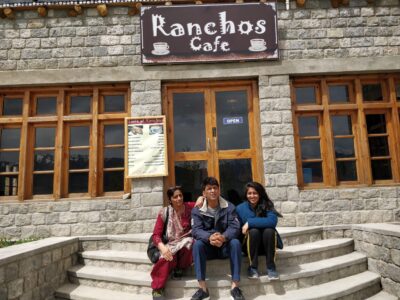
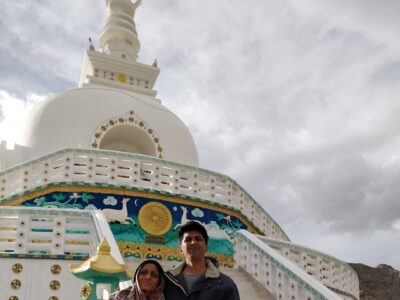
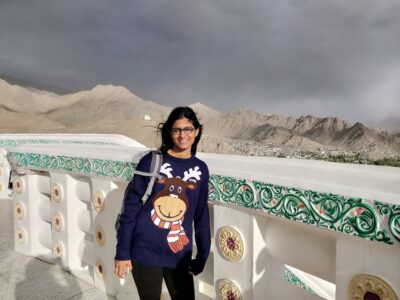
Food
In Leh, the street vendors sell fresh produce from their gardens and the shops stock dry fruits – apricots that grow locally. Explore to see some interesting local food and produce like the yak cheese churpi. The restaurants offer burgers to local cuisine. Try the Thukpa or Thenthuk a noodle soup that is a wholesome meal.
However, overall, food choices are limited for vegetarians, given that there is little that grows around here. Most places serve delicious, lentils and rice and potato-capsicum mixed vegetable. The lentils may vary from yellow lentils/ kidney beans/ chickpeas/ etc. Maggi and tea are omnipresent. Yogurt/ Curd is available very rarely. You can carry you ready to eat packets and most roadside hotels will pop it into boiling water for you. Take the opportunity to drink endless cups of local green tea and butter tea too. Make sure to eat whenever you find food – high carb diets help with the high altitude, and you also never know when and where you will find your next meal stop.
How about trying yak’s milk? It is an important item in the diets of communities living in high-altitude regions where yaks are prevalent. Rich in protein, nutrients and fat (note, those on Keto!).
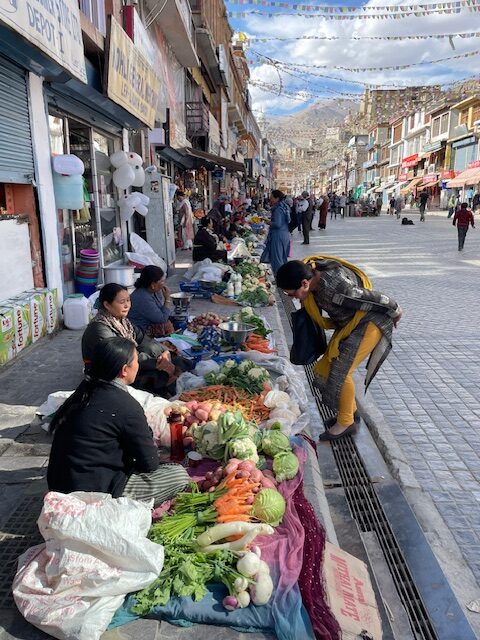
Narrative of Ladakh on a Motorbike and Pictures
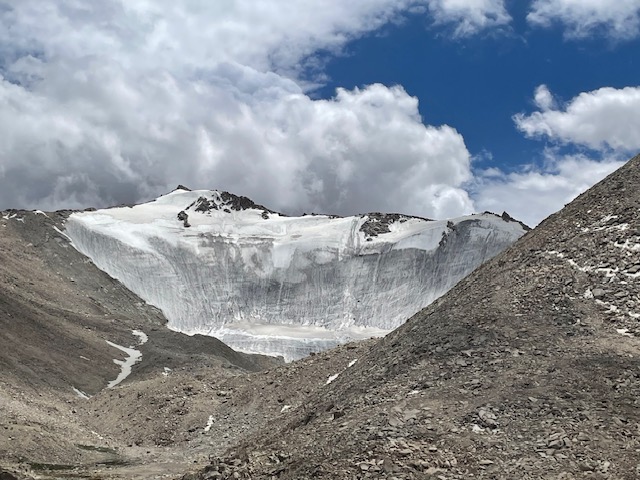
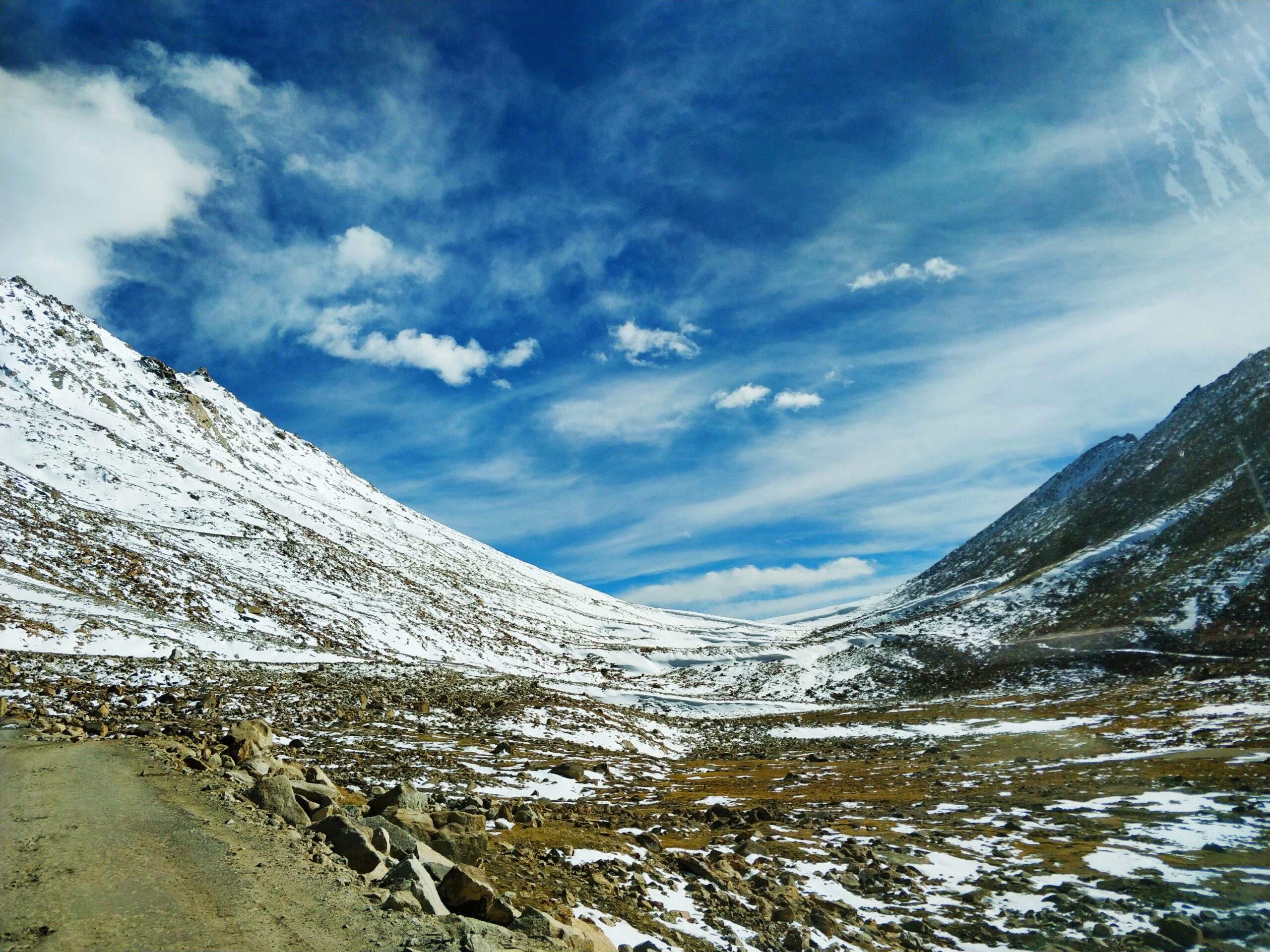
Ladakh is the Himalayan Dessert Region and is awe inspiring for its panoramic landscapes and mountainscapes. The highest motorable roads in the world are in this region, making it a biker’s dream come true if they get to do a Leh Ladakh bike trip. One will meet bikers, loners, small groups and large organized troupes all along the way. Cars and buses are also plenty. But yes Leh Ladakh on a bike is a dream! Bikes for rent are available all along the way. Also, refer to this excellent link attractions | Incredible India to see all the places to visit and activities in Leh Ladakh (whether or not you are doing a motorbike trip).
Given that this was road trip and the route and itself and sights around you are amazingly awesome, there cannot be a separate phrase called ‘sight-seeing’! The terrain is stunningly beautiful and imposing. The magnificent mountain all round you are just magnificent in their bare rawness. Very different from the lush ranges one sees in the eastern ranges of the Himalayas.
There are a few stops on the way that need to be highlighted:
Kargil: The Kargil war memorial in Drass is a tribute to the valor of the Indian Army. A very imposing and solemn. It draws tourist from all over, wanting to hear the tales of valor. A photo exhibition, installations and a AV provide plenty of information.
The Pather Sahib Gurudwara: One of the significant gurudwaras in the region it provides solace among the stunning mountains. It is welcoming of the traveller. One stops to ponder over the spirit of human life and its significance. The gurudwara also offers a cup of tea and rusk to anyone who passes by and the langar twice a day is healing. The gurudwara is maintained by the Indian Army.
Monasteries: There are many Buddhist monasteries all along the route.
Leh: Leh town, the largest in this region, is a beautiful and significant stop on the route. The market at the foothills of the Leh Palace is vibrant and well stocked. A cobbled, walkers only street, it has friendly seating for you to sit and soak the vibrant place in. You will find banks, shops, restaurants, and the warmth of local folks.
The Leh Palace on top the hill is also busy with visitors and tourists and gives you a panoramic view of the surroundings.
Khardungla Pass: Khardungla Pass is the currently the second highest motorable road in the world. The highest motorable road in the world is Umling La, also in Leh Ladakh. Umling La will soon become the second highest as work has started on another road higher that it in the same region. The way up to Khardungla is steep and strenuous. You see some folks cycling all the way up and are in complete disbelief. Once you reach the top, you feel elated and breathless all at once. A short stop is all that one can handle, before getting a few gasps of oxygen from the cylinders and making your way quickly down the mountains. There are a couple of tea stalls selling tea and Maggi noodles.
Nubra Valley: Shyok River Adventure!
We traveled from Diskit to Durbuk along the Nubra Valley and the Shyok River. This is a no network, no habitation region. A patchy, rocky path in the valley, surrounded by stark mountains. Melting glacial streams and waterfalls springing up as the sun rises overhead. Paths getting submerged and blocked by water. Some were easy and some were daunting. The waterfalls powerful enough to sweep bikes and cars off! As the sun goes higher, the flow of water increases, and new flows emerge and block your path. Bikers and vehicles waited to group, test the path, and then help each other across. One car got stuck in the rocks and had to be towed. all waited till the path was cleared. Our car stepney fell off at one of the bumpiest crossings and we did not even notice it! We crossed 5 of these that day. It took all of 8 hours to cross just 100 kms. As the sun went down and darkness descended a silence and a need to hurry was felt. We all made it, tired and triumphant.
Pangong Tso:
Pangong Tso was the most magical lake! We stayed the night there. The deep colors are mesmerizing. 1/3 of the lake is in India and the rest flows into China. The mountains in the backdrop look like the fingers of a closed fist. Ones sees what are referred to as fingers in the news. It is saltwater lake. We witnessed the most magical and rare rainbow over the lake. The air is still rare and the oxygen cylinders were put to use. The night sky is crystal clear and dramatic.
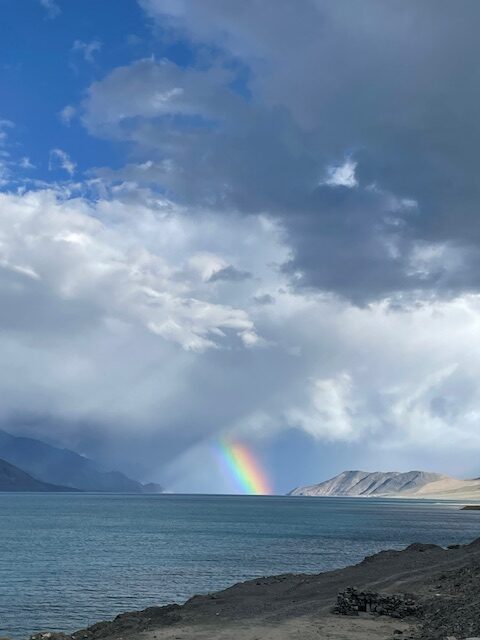
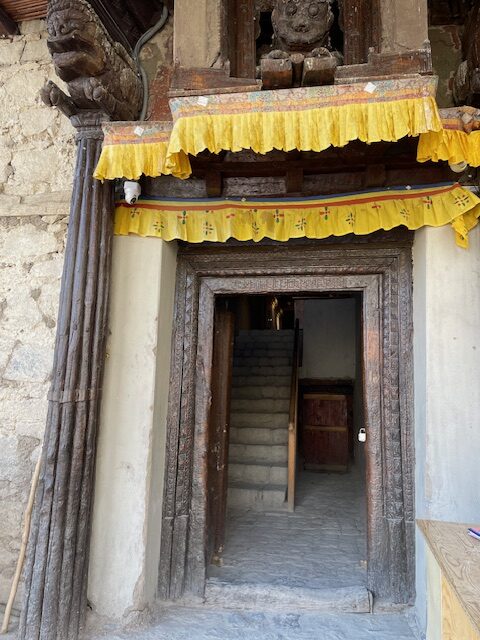
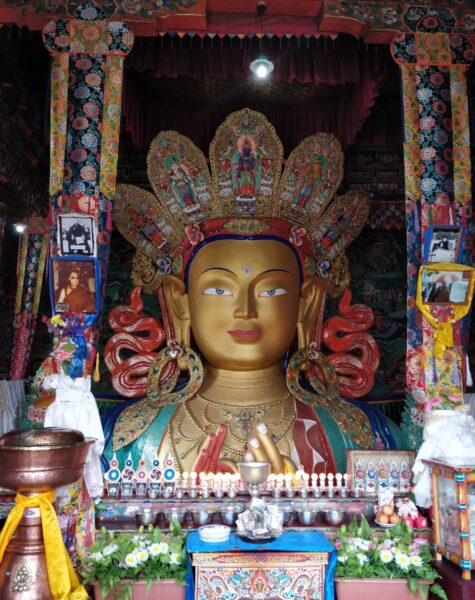
Reaching Leh
There are many roads to Leh Ladakh. One can land at the Leh Airport and then do a road trip. One could take the Manali Road to Leh by public and private roadways buses or hired and personal transport. You can also reach Leh via the Srinagar Route. Each of these has its own advantages and challenges.
As mentioned earlier, the Leh Airport is well connected and is open through the year.
The road via Manali is considered beautiful and easy. Traveling by road, allows for your body to get acclimatized gradually as you climb up into the elevation.
The road via Jammu and Srinagar is the most challenging and exciting. This weaves way through Jammu Srinagar Sonmarg, Kargil onwards to Leh. This was the route we travelled.
Whichever route you take,
- Make sure to get your doctors advise on medication for high altitude sickness.
- Carry along oxygen cylinders and take whiffs whenever you need to. The impact of low oxygen levels is asymptomatic most times – you may just feel tired and sleepy. So be watchful and prepared.
- Learn to go with the flow – all your best laid schedules and plans may be put to test and rest depending on the weather, the road conditions, roadblocks and detours and the incidents with the vehicles – punctures etc. Like they say – when in the mountains, the mountains decide your route and schedules.
- Another mountain rule is that eat when food is available, you never know when you will find your next meal stop.
- Make sure to consciously keep hydrated – the cool air doesn’t make you feel obviously thirsty.
- Travel light – most stays are basic and be prepared to lug your luggage. Plenty of undergarments, a few inner wears and two sets of outer wear – heavy and light.
- Moisturizers, lip balms and sunscreens are necessary.
- If you are on a two-wheeler, like I was, make sure to wear the right gear and all of it- really helps when you have falls
The Route
The onward route starting from Meerut to Pathankot to Jammu to Srinagar to Sonmarg to Kargil to Diskit to Durbuk to Panagong. View the terrain map to get an idea.
The return was to be through Tso Morori and the Manali route, but the road closure had us changing our plan and we exited from Pangong to Lamayuru, to Srinagar and out.
On the route from Jammu to Srinagar – we travelled the historic trade route – the Mughal route. The road work is in progress and riding this winding mountainous road was a challenge in the heavy rain that pounded down. One must make special mention of the roads that BRO builds at those heights! They put the potholed rods in or cities to shame. However, landslides and falling rocks cause damage and so many patches are always work-in-progress. One also has special admiration for the workers working on these roads at those heights. Where even little activity makes you feel breathless, these folks are doing hard labor! Hats off to them. Leh Ladakh being a border region, there is heavy and constant military presence all along the route.
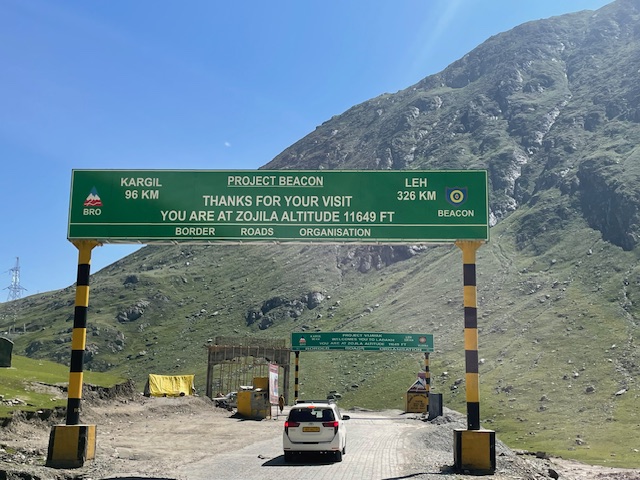
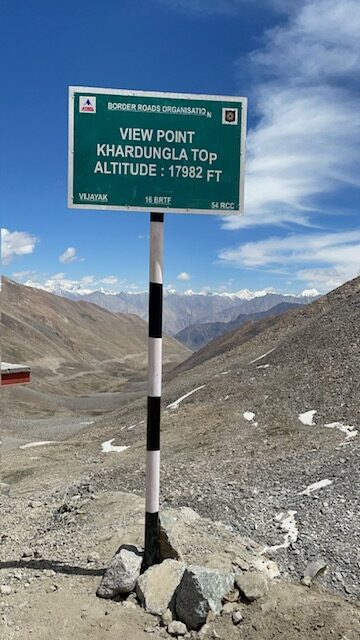

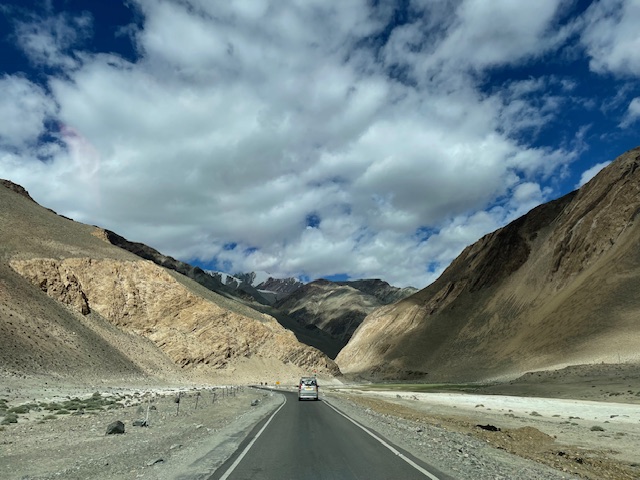
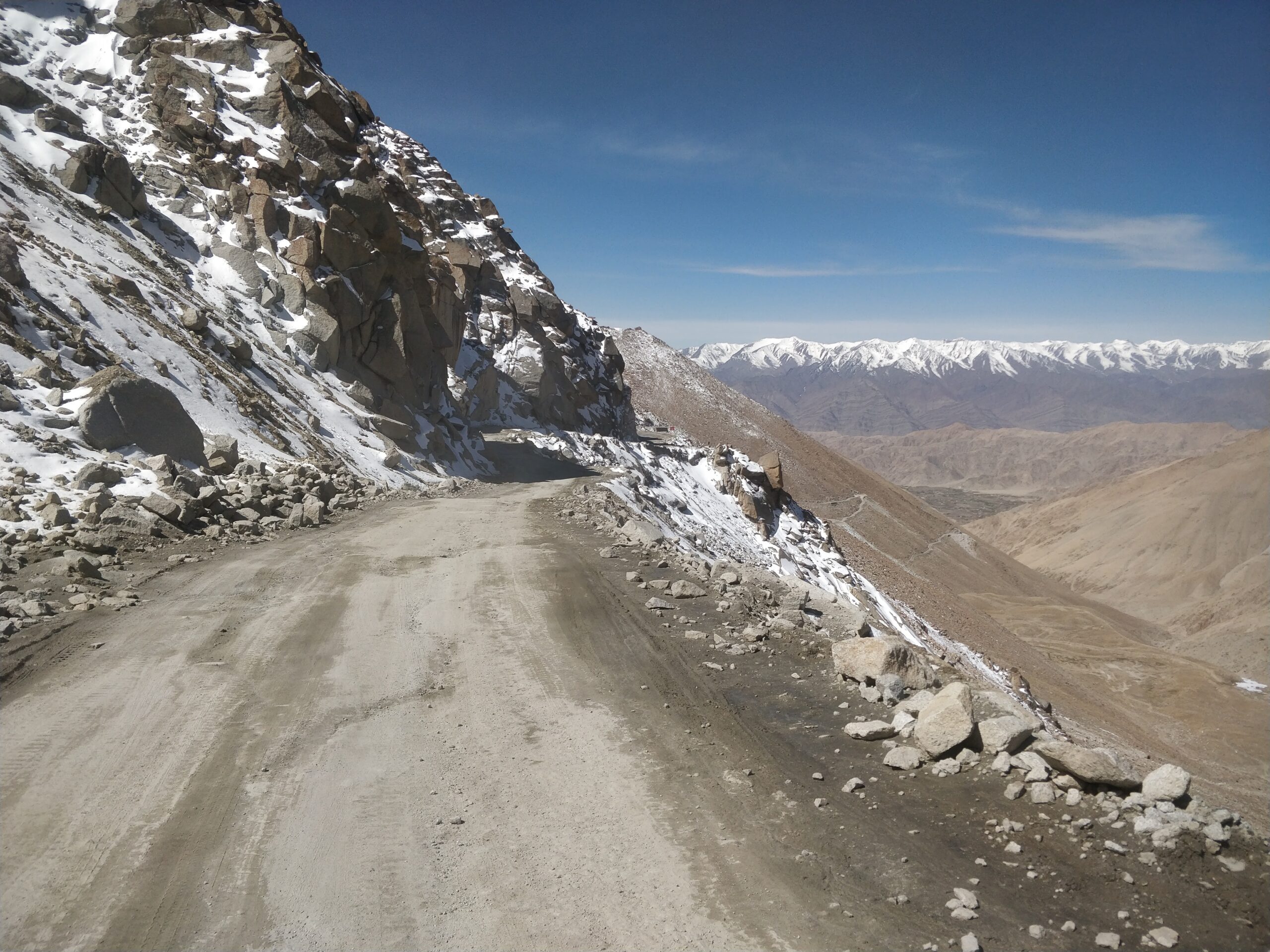
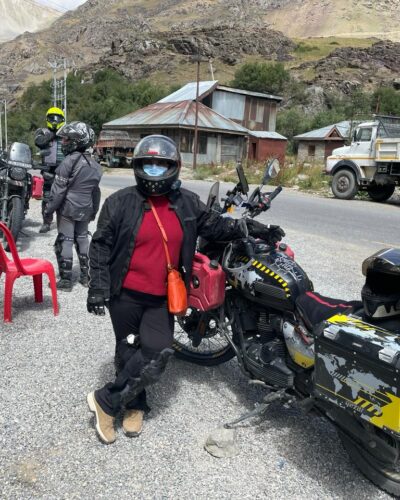
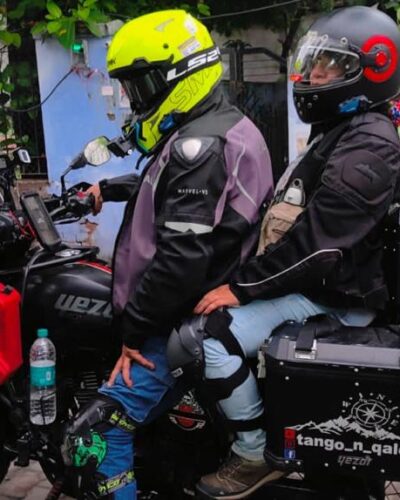
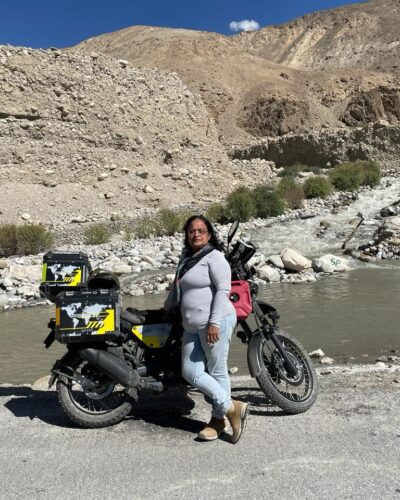
Stays
All the settlements along the way have small home stays and inns. The facilities are basic and homely. Expect to have a clean bed and a bathroom. Hot water is provided on buckets. One must remember that most of Leh Ladakh does not have electricity at nighttime.
We were a group of six on three bikes. Additionally, we had a SUV and a driver, to hold all our luggage and seats for anyone who was unwell or needed to travel in the car sometimes. Riding on a motorbike, I think is the best way to do Leh-Ladakh! It is a multi-sensory experience- the views, the sounds, the feeling of being one with the road, is unbelievably awesome! This is a dream that most bikers want to meet-
We covered 3000 odd kms from Aug 05th to 17th 2023. You meet many biker – groups on the way. Several of them returning for the third or fourth time.
People
The locals are the gentlest and friendliest of people you will meet. Ever smiling and every helpful, they greet you with a ‘Julley’ (Hello/ thank you / goodbye) They will offer you tea, and dig into their pockets to give you handfuls of dry fruit to munch on.
The Rivers
Riding along the many rivers one has seen on maps and read about in the history and geography textbooks in school. The Indus, The Chenab, The Shyok and many smaller ones. The rivers were exciting and challenging. While we rode along some, we had to wade through some! Some were impromptu glacial melt streams and waterfalls which one needed to assess and navigate. It was exciting to see ‘Indus Valley Road’ come up on the map! The Shyok river, which I hadn’t been aware of was the most challenging.
The Landscape
The landscape is amazing. Everywhere you look the mountains loom – rugged and majestic. The skies are like huge canvases. Amazing blues and clouds. The route up to Zojila Pass is lush and green. The mountains have vegetation and on the return, we also saw the carpets of wild flowers that bloom. The Zojila pass tunnel is under construction and the road is patchy and challenging. The winds are stiff and rattle you. Once you cross the Zojila Pass into Kargil, the landscapes changes into a stark, mostly barren rocky mountain. You are in the Himalayan dessert region. You can see and sense the difference. The air is drier and so is the land. Melting glacier streams /waterfalls cross your way. Signs of ‘falling rock’ and ‘avalanche’ area are all along the road. You ride in silence as the strong winds roar in your ears. The barren, sandy valleys stun you. Green oasis where there is a catchment for the melting glacial waters, are a welcome sight.
The resilience of life and humankind is a thought that stays with you. It is admirable how life habitats, thrive and nourish in these terrains.
Free Subscribe
HOW YOU CAN SUPPORT THIS SITE
- Leave a comment on this page (scroll down), share your own experiences if you have already been to this place.
- Subscribe to travelstosavour and receive 2 free blog posts per month, featuring 2 new destinations (scroll down to the footer to subscribe).
- Follow travelstosavour on social media – Facebook, Instagram and Youtube (by a click of the button in the footer) and share all the goodies with your pals!
Check out other destinations and nature escapes on this site.


WANT A CUSTOM ITINERARY?
No time or inclination to delve into detailed vacation-planning? No worries!
Let’s talk…..I can curate and customize a day-by-day itinerary for you.
Remember to visit Services & About for more details.


